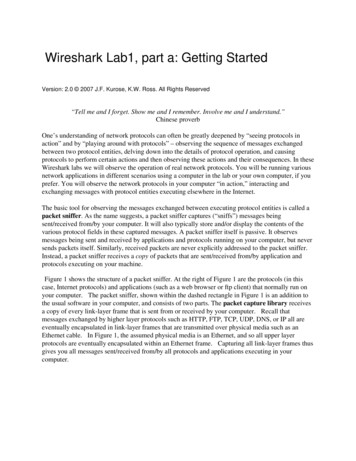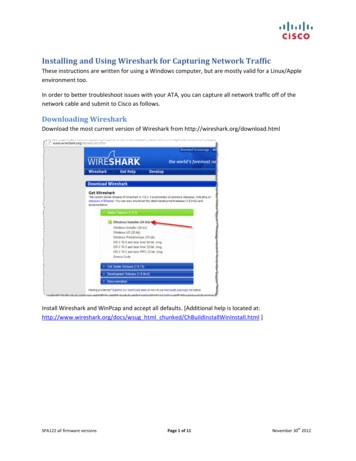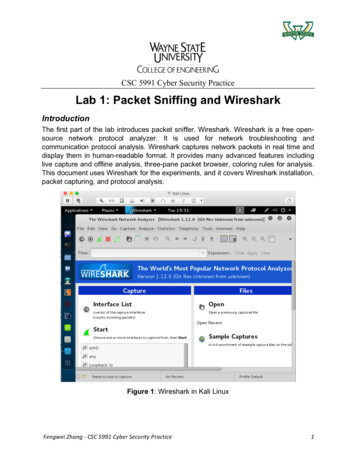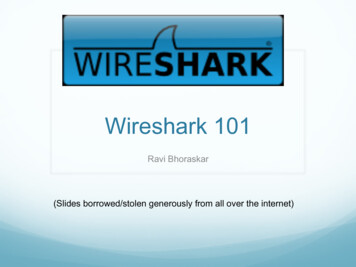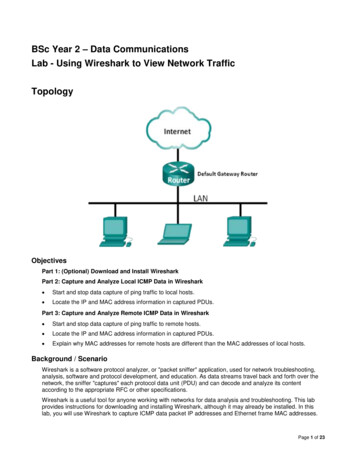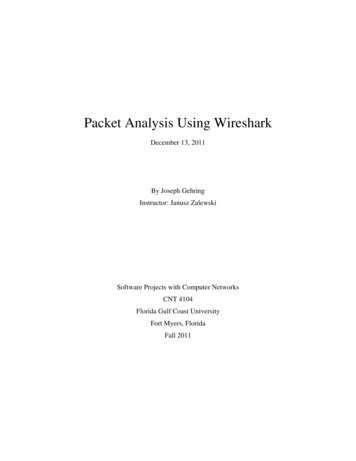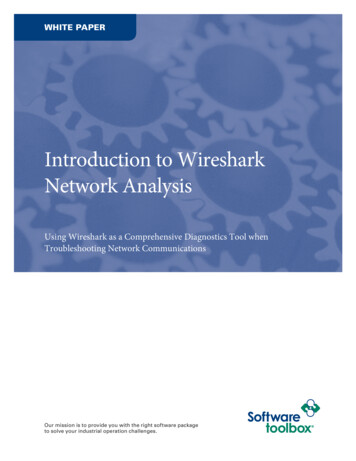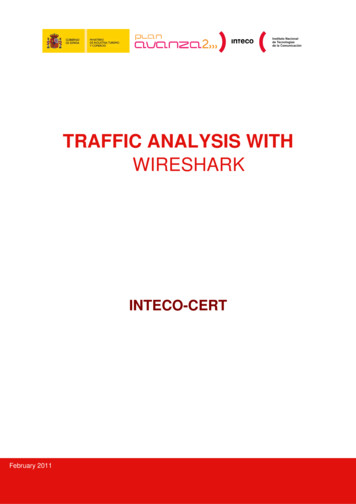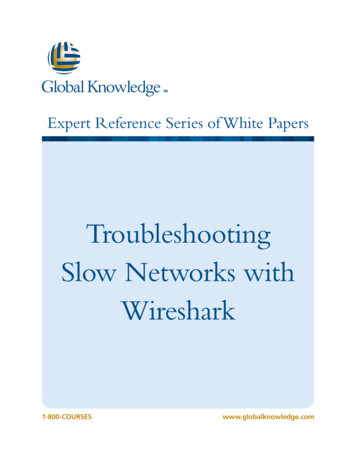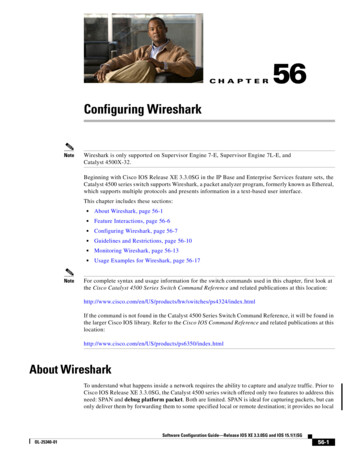
Transcription
CH A P T E R56Configuring WiresharkNoteWireshark is only supported on Supervisor Engine 7-E, Supervisor Engine 7L-E, andCatalyst 4500X-32.Beginning with Cisco IOS Release XE 3.3.0SG in the IP Base and Enterprise Services feature sets, theCatalyst 4500 series switch supports Wireshark, a packet analyzer program, formerly known as Ethereal,which supports multiple protocols and presents information in a text-based user interface.This chapter includes these sections:Note About Wireshark, page 56-1 Feature Interactions, page 56-6 Configuring Wireshark, page 56-7 Guidelines and Restrictions, page 56-10 Monitoring Wireshark, page 56-13 Usage Examples for Wireshark, page 56-17For complete syntax and usage information for the switch commands used in this chapter, first look atthe Cisco Catalyst 4500 Series Switch Command Reference and related publications at this itches/ps4324/index.htmlIf the command is not found in the Catalyst 4500 Series Switch Command Reference, it will be found inthe larger Cisco IOS library. Refer to the Cisco IOS Command Reference and related publications at s6350/index.htmlAbout WiresharkTo understand what happens inside a network requires the ability to capture and analyze traffic. Prior toCisco IOS Release XE 3.3.0SG, the Catalyst 4500 series switch offered only two features to address thisneed: SPAN and debug platform packet. Both are limited. SPAN is ideal for capturing packets, but canonly deliver them by forwarding them to some specified local or remote destination; it provides no localSoftware Configuration Guide—Release IOS XE 3.3.0SG and IOS 15.1(1)SGOL-25340-0156-1
Chapter 56Configuring WiresharkAbout Wiresharkdisplay or analysis support. The debug platform packet command is specific to the Catalyst 4500 seriesswitch and only works on packets that stem from the software process-forwarding path. Although it haslimited local display capabilities, it has no analysis support.So the need exists for a traffic capture and analysis mechanism that is applicable to both hardware andsoftware forwarded traffic and that provides strong packet capture, display and analysis support,preferably using a well known interface.Wireshark dumps packets to a file using a well known format called .pcap, and is applied or enabled onindividual interfaces. You specify an interface in EXEC mode along with the filter and other parameters.The Wireshark application is applied only when you enter a start command and is removed only whenWireshark stops capturing packets either automatically or manually.NoteIn Cisco IOS Release XE 3.3.0SG, global packet capture on Wireshark is not supported.These sections describe some key concepts for Wireshark: Capture Points, page 56-2 Attachment Points: Interfaces and traffic directions, page 56-2 Filters, page 56-3 Actions, page 56-4 Storing Captured Packets to Buffer in Memory, page 56-4Capture PointsA capture point is the central policy definition of the Wireshark feature. The point describes all thecharacteristics associated with a given instance of Wireshark: what packets to capture, where to capturethem from, what to do with the captured packets, and when to stop. Capture points can be modified aftercreation and do not become active until explicitly activated with a start command. This process is termedactivating the capture point or starting the capture point. Capture points are identified by name and mayalso be manually or automatically deactivated or stopped.Multiple capture points may be defined and activated simultaneously.Attachment Points: Interfaces and traffic directionsAn attachment point is a point in the logical packet process path associated with a capture point.Consider an attachment point as an attribute of the capture point. Packets that impact an attachment pointare tested against the capture point's filters; packets that match are copied and sent to the capture point'sassociated Wireshark instance. A specific capture point can be associated with multiple attachmentpoints, with limits on mixing attachment points of different types. Some restrictions apply when youspecify attachment points of different types. Attachment points are directional (input or output or both)with the exception of the Layer 2 VLAN attachment point, which is always bidirectional.Software Configuration Guide—Release IOS XE 3.3.0SG and IOS 15.1(1)SG56-2OL-25340-01
Chapter 56Configuring WiresharkAbout WiresharkFiltersFilters are attributes of a capture point that identify and limit the subset of traffic traveling through theattachment point of a capture point, which is copied and passed to Wireshark. To be displayed byWireshark, a packet must pass through an attachment point, as well as all of the filters associated withthe capture point.A capture point has three types of filters: Core system filter—The core system filter is applied by hardware, and its match criteria is limitedby hardware. This filter determines whether hardware-forwarded traffic is copied to software forWireshark purposes. Capture filter—The capture filter is applied by Wireshark. The match criteria are more granular thanthose supported by the core system filter. Packets that pass the core filter but fail the capture filterare still copied and sent to the CPU/software, but are discarded by the Wireshark process. Thecapture filter syntax matches that of the display filter.Note Wireshark on the Catalyst 4500 series switch does not use the syntax of the capture filter.Display filter—The display filter is applied by Wireshark, and its match criteria are similar to thoseof the capture filter. Packets that fail the display filter are not displayed.Core System FilterYou can specify core system filter match criteria by using the class map or ACL, or explicitly by usingthe CLI.In some installations, you need to obtain authorization to modify the switch configuration, which canlead to extended delays if the approval process is lengthy. This would limit the ability of networkadministrators to monitor and analyze traffic. To address this situation, Wireshark supports explicitspecification of core system filter match criteria from the EXEC mode CLI. The disadvantage is that thematch criteria that you can specify is a limited subset of what class map supports, such as MAC, IPsource and destination addresses, ether-type, IP protocol, and TCP/UDP source and destination ports.If you prefer to use configuration mode, you can define ACLs or have class maps refer capture points tothem. Explicit and ACL-based match criteria are used internally to construct class maps and policy maps.These implicitly constructed class maps are not reflected in the switch running-config and are notNVGEN’d.NoteThe configuration of ACL and class-map are part of the system and not aspects of the Wireshark featureCapture FilterThe capture filter allows you to direct Wireshark to further filter incoming packets based on variousconditions. Wireshark applies the capture filter immediately on receipt of the packet; packets that failthe capture filter are neither stored nor displayed.A switch receives this parameter and passes it unchanged to Wireshark. Because Wireshark parses theapplication filter definition, the defining syntax is the one provided by the Wireshark display filter. Thissyntax and that of standard Cisco IOS differ, which allows you to specify ACL match criteria that cannotbe expressed with standard syntax.Software Configuration Guide—Release IOS XE 3.3.0SG and IOS 15.1(1)SGOL-25340-0156-3
Chapter 56Configuring WiresharkAbout WiresharkNoteThe capture filter syntax matches that of the Wireshark display filter. The syntax for capture and displayfilters are identical in the Wireshark implementation on the Catalyst 4500 series switch.Display FilterWith the display filter, you can direct Wireshark to further narrow the set of packets to display whendecoding and displaying from a .pcap file. Because the syntax of the display filter is identical to thecapture filter, the display filter is superfluous if a capture filter is also defined.For more details on the syntax of capture and display filters, go ireshark can be invoked on live traffic or on a previously existing .pcap file. When invoked on livetraffic, it can perform four types of actions on packets that pass its capture and display filters: Captures to buffer in memory to decode and analyze and store Stores to a .pcap file Decodes and displays Stores and displaysWhen invoked on a .pcap file only, only the decode and display action is applicable.Storing Captured Packets to Buffer in MemoryPackets can be stored in the capture buffer in memory for subsequent decode, analysis, or storage to a.pcap file.The capture buffer can be linear or circular mode. In linear mode, new packets are discarded when thebuffer is full. In circular mode, if the buffer is full, the oldest packet are discarded to accommodate thenew packet. Although the buffer can also be cleared when needed, this mode is mainly used fordebugging network traffic.Storing Captured Packets to a .pcap FileWireshark can store captured packets to a .pcap file. The capture file can be located on the followingstorage devices: Catalyst 4500 series switch on-board flash storage (bootflash:) external flash disk (slot:) USB drive (usb0:)NoteDo not attempt to use Wireshark with any other devices.Software Configuration Guide—Release IOS XE 3.3.0SG and IOS 15.1(1)SG56-4OL-25340-01
Chapter 56Configuring WiresharkAbout WiresharkWhen configuring a Wireshark capture point, you can associate a filename. When the capture point isactivated, Wireshark creates a file with the specified name and writes packets to it. If the file alreadyexists when the file is associated or the capture point is activated, Wireshark queries you as to whetherthe file can be overwritten. Only one capture point may be associated with a given filename.If the destination of the Wireshark writing process is full, Wireshark fails with partial data in the file.You must ensure that there is sufficient space in the file system before you start the capture session. WithCisco IOS Release IOS XE 3.3.0SG, the file system full status is not detected for some storage devices.You can reduce the required storage space by retaining only a segment, instead of the entire packet.Typically, you do not require details beyond the first 64 or 128 bytes. The default behavior is to store theentire packet.To avoid possible packet drops when processing and writing to the file system, Wireshark can optionallyuse a memory buffer to temporarily hold packets as they arrive. Memory buffer size can be specifiedwhen the capture point is associated with a .pcap file.Decoding and Displaying PacketsWireshark can decode and display packets to the console. This functionality is possible for capture pointsapplied to live traffic and for capture points applied to a previously existing .pcap file.NoteDecoding and displaying packets may be CPU intensive.Wireshark can decode and display packet details for a wide variety of packet formats. The details aredisplayed by entering the monitor capture name start command with one of the following keywordoptions, which place you into a display and decode mode: brief—Displays one line per packet (the default). detailed—Decodes and displays all the fields of all the packets whose protocols are supported.Detailed mode require more CPU than the other two modes. (hexadecimal) dump—Displays one line per packet as a hexadecimal dump of the packet data andthe printable characters of each packet.When we enter the capture command with the decode and display option, the Wireshark output isreturned to Cisco IOS and displayed on the console unchanged.Displaying Live TrafficWireshark receives copies of packets from the Catalyst 4500 series switch core system. Wiresharkapplies its capture and display filters to discard uninteresting packets, and then decodes and displays theremaining packets.Displaying from .pcap FileWireshark can decode and display packets from a previously stored .pcap file and direct the display filterto selectively displayed packets. A capture filter is not applicable in this situation.Storing and Displaying PacketsFunctionally, this mode is a combination of the previous two modes. Wireshark stores packets in thespecified .pcap file and decodes and displays them to the console. Only the core and capture filters areapplicable here.Software Configuration Guide—Release IOS XE 3.3.0SG and IOS 15.1(1)SGOL-25340-0156-5
Chapter 56Configuring WiresharkFeature InteractionsActivating and Deactivating Wireshark Capture PointsAfter a Wireshark capture point has been defined with its attachment points, filters, actions, and otheroptions, it must be activated. Until the capture point is activated, it does not actually capture packets.Before a capture point is activated, some sanity checks are performed. A capture point cannot beactivated if it has neither a core system filter nor attachment points defined. Attempting to activate acapture point that generates an error.The capture and display filters are specified as needed.After Wireshark capture points are activated, they can be deactivated in multiple ways. A capture pointthat is storing only packets to a .pcap file can be halted manually or configured with time or packet limits,after which the capture point halts automatically. Only packets that pass the Wireshark capture filter arecounted against the packet limit threshold.When a Wireshark capture point is activated, a fixed rate filter is applied automatically in the hardwareso that the CPU is not flooded with Wireshark-directed packets. The disadvantage of the rate filter is thatyou cannot capture contiguous packets beyond the established rate even if more resources are available.Feature InteractionsThis section describes how Wireshark features function in the Catalyst 4500 series switch environment: Layer 2 security features—Packets that are dropped by Layer 2 security features (such as portsecurity, MAC address filtering, and spanning tree) are not captured by Wireshark. This differs fromthe behavior of SPAN. Classification-based security features—Packets that are dropped by input classification-basedsecurity features (such as ACLs and IPSG) are not caught by Wireshark capture points that areconnected to attachment points at the same layer. In contrast, packets that are dropped by outputclassification-based security features are caught by Wireshark capture points that are connected toattachment points at the same layer. The logical model is that the Wireshark attachment point occursafter the security feature lookup on the input side, and symmetrically before the security featurelookup on the output side.Wireshark capture policies connected to Layer 2 attachment points in the input direction capturepackets dropped by Layer 3 classification-based security features. Symmetrically, Wiresharkcapture policies attached to Layer 3 attachment points in the output direction capture packetsdropped by Layer 2 classification-based security features. Routed ports and Layer 3 port channels—When a routed port or Layer 3 port channel is used as aWireshark attachment point, the The policy that is applied to capture the packets is treated asattached at Layer 3. Wireshark only captures packets that are being routed by the interface. VLANs—When a VLAN is used as a Wireshark attachment point, packets are captured in both inputand output directions. A packet that is bridged in the VLAN generates two copies, one on input andone on output. Private VLANs—Secondary PVLANs are disallowed as Wireshark attachment points. Using aprimary PVLAN as a Wireshark attachment point enables capture of packets in the primary PVLANand all associated secondary PVLANs. The entire PV domain becomes the attachment point.Software Configuration Guide—Release IOS XE 3.3.0SG and IOS 15.1(1)SG56-6OL-25340-01
Chapter 56Configuring WiresharkConfiguring Wireshark Redirection features—In the input direction, features traffic redirected by Layer 3 (such as PBR andWCCP), are logically later than Layer 3 Wireshark attachment points. Wireshark captures thesepackets even though they might later be redirected out another Layer 3 interface. Symmetrically,output features redirected by Layer 3 (such as egress WCCP) are logically prior to Layer 3Wireshark attachment points, and Wireshark will not capture them. Classification copy features—Features that generate copies of packets from the role-based andSecurity lookup types are compatible with Wireshark. Multiple copies of these packets aregenerated. SPAN—Wireshark and SPAN sources are compatible. You can configure an interface as a SPANsource and as a Wireshark attachment point simultaneously. Configuring a SPAN destination port asa Wireshark attachment point is not supported.There are four classification results for input and output classification. In the input direction, they areordered role-based, security, QoS, and forwarding override. In the output direction they are orderedforwarding override, role-based, security, and QoS.On the input side, the Wireshark capture feature is placed in the forwarding override result type,prioritized above the other FO features (such as multicast local source capture, PBR and ingress WCCP).The packets captured by Wireshark are before any redirection by PBR or WCCP. Because security ACLsare applied ahead of FO-related features, packets that are dropped by security ACLs are not captured byWireshark.On the output side, the Wireshark capture feature is placed in the forwarding override result type,prioritized below the other FO features (such as egress WCCP). Wireshark captures packets only if theother egress FO features do not apply.Configuring WiresharkThe CLI for configuring Wireshark requires that the feature be executed only from EXEC mode. Actionsthat usually occur in configuration submode (such as defining capture points), are handled at the EXECmode instead. All key commands are not NVGEN’d and are not synchronized to the standby supervisorin NSF and SSO scenarios.The following sections describe how to configure Wireshark: Default Wireshark Configuration, page 56-7 Wireshark Configuration Guidelines, page 56-8 Defining, Modifying, or Deleting a Capture Point, page 56-8 Activating and Deactivating a Capture Point, page 56-10Default Wireshark ConfigurationTable 56-1 shows the default Wireshark configuration.Table 56-1Default Wireshark ConfigurationFeatureDefault SettingDurationNo limitPacketsNo limitPacket-lengthNo limit (full packet)Software Configuration Guide—Release IOS XE 3.3.0SG and IOS 15.1(1)SGOL-25340-0156-7
Chapter 56Configuring WiresharkConfiguring WiresharkTable 56-1Default Wireshark ConfigurationFeatureDefault SettingFile sizeNo limitRing file storageNoBuffer storage modeLinearWireshark Configuration GuidelinesWhen configuring Wireshark, ensure the following: Traffic is active on the interfaces the Wireshark policy is applied on. Filter rules match the traffic. Mandatory parameters are configured.Defining, Modifying, or Deleting a Capture PointAlthough listed in sequence, the steps to specify values for the options can be executed in any order. Youcan also specify them in one, two, or several lines. Except for attachment points, which can be multiple,you can replace any value with a more recent value by respecifying the same option, in the followingorder:Step 1Define the name that identifies the capture point.Step 2Specify the attachment point with which the capture point is associated.Multiple attachment points can be specified. Range support is also available both for adding andremoving attachment points.Step 3Define the core system filter, defined either explicitly, through ACL or through a class map.Step 4Specify the session limit (in seconds or packets captured).Step 5Specify the packet segment length to be retained by Wireshark.Step 6Specify the file association, if the capture point intends to capture packets rather than merely displaythem.Step 7Specify the size of the memory buffer used by Wireshark to handle traffic bursts.To filter the capture point, use the following commands:CommandPurpose[no] monitor capture mycap match {any macmac-match-string ipv4 ipv4-match-string ipv6ipv6-match-string}Defines an explicitly in-line core filter.To remove the filter, use the no form of this command.Software Configuration Guide—Release IOS XE 3.3.0SG and IOS 15.1(1)SG56-8OL-25340-01
Chapter 56Configuring WiresharkConfiguring WiresharkCommandPurpose[no] monitor capture mycap match mac {src-mac-addrsrc-mac-mask any host src-mac-addr} {dest-mac-addrdest-mac-mask any host dest-mac-addr}Specifies use of a filter for MAC.To remove the filter, use the no form of this command.[no] monitor capture mycap match {ipv4 ipv6}Specifies a filter for IPv4/IPv6, use one of the formats.[src-prefix/length any host src-ip-addr] [dest-prefix/lengthTo remove the filters, use the no form of this command. any host dest-ip-addr][no] monitor capture mycap match {ipv4 ipv6} proto{tcp udp} [src-prefix/length any host src-ip-addr] [eq gt lt neq 0-65535 ] [dest-prefix/length any hostdest-ip-addr] [eq gt lt neq 0-65535 ]To define a capture point, use the following commands:CommandPurposemonitor capture name [{interface name vlan num control-plane} {in out both}Specifies one or more attachment points with direction.To remove the attachment point, use the no form of thiscommand.monitor capture name [[file location filename [buffer-size Specifies the capture destination. 1-100 ] [ring 2-10 ] [size 1-100 ]] [buffer [circular]To remove the details, use the no form of this command.size 1-100 ]][no] monitor capture name limit {duration seconds][packet-length size] [packets num]Specifies capture limits.To remove the limits, use the no form of this command.To clear the buffer contents, use the following commandCommandPurposemonitor capture [clear export filename]Clears capture buffer contents or stores the packets to a file.To start and stop a capture point, use the following command:CommandPurposemonitor capture name start [capture-filter filter-string][display [display-filter filter-string]] [brief detailed dump stop]To start or stop a capture point, use the monitor capturecommand.ExamplesAssociating/disassociating a capture fileSwitch# monitor capture point mycap file location bootdisk:mycap.pcapSwitch# no monitor capture mycap fileSoftware Configuration Guide—Release IOS XE 3.3.0SG and IOS 15.1(1)SGOL-25340-0156-9
Chapter 56Configuring WiresharkGuidelines and RestrictionsSpecifying a memory buffer size for packet burst handlingSwitch# monitor capture mycap buffer-size 1000000Defining an explicit core system filter to match both IPv4 and IPv6 TCP trafficSwitch# monitor capture mycap match any protocol tcpDefining a core system filter using an existing ACL or class-mapSwitch# monitor capture mycap match access-list myaclSwitch# monitor capture mycap match class-map mycmActivating and Deactivating a Capture PointA capture point cannot be activated unless an attachment point and a core system filter have been definedand the associated filename (if any) does not already exist. A capture point with no associated filenamecan only be activated to display. If no capture or display filters are specified, all of the packets capturedby the core system filter are displayed. The default display mode is brief.To activate or deactivate a capture point, perform these tasks:CommandPurposemonitor capture name start [capture-filter filter-string] Activates a capture point.[display [display-filter filter-string]] [brief detailed dump]Deactivates a capture point.monitor capture name stopExample:Switch# monitor capture mycap start capture-filter"net 10.1.1.0 0.0.0.255 and port 80"Switch# monitor capture mycap start displaydisplay-filter "net 10.1.1.0 0.0.0.255 and port80"Guidelines and Restrictions When packet capture is enabled in the input direction, the matching packets undergo software-basedlookup in the CPU for the first 15 seconds. During this time, CPU usage is high and capture rate islow. When packet capture is enabled in the output direction, packets are not captured in the first 15seconds. Packets captured in the output direction of an interface might not reflect the changes made by switchrewrite (includes TTL, VLAN tag, CoS, checksum, and MAC addresses). Capturing at a physical port that belongs to another logical port may not be supported. For example,capturing at EtherChannel member ports is not supported. Limiting circular file storage by file size is not supported.Software Configuration Guide—Release IOS XE 3.3.0SG and IOS 15.1(1)SG56-10OL-25340-01
Chapter 56Configuring WiresharkBest Practices Wireshark cannot capture IPv6 packets if the capture point's class-map filter is attempting to matchone of the following:– Extension headers followed by Hop-by-hop header (as per CSCtt16385)– DSCP values (as per CSCtx75765)Best PracticesConsider the following best practices: During Wireshark packet capture, hardware forwarding happens concurrently. Before starting a Wireshark capture process, ensure that CPU usage is moderate and that sufficientmemory (at least 200 MB) is available. If you plan to store packets to a storage file, ensure that sufficient space is available before beginninga Wireshark capture process. The CPU usage during Wireshark capture depends on how many packets match the specifiedconditions and on the intended actions for the matched packets (store, decode and display, or both). Limit packet capture with parameters of the capture point command (like packet number andcapture duration). Because packet forwarding typically occurs in hardware, packets are not copied to the CPU forsoftware processing. For Wireshark packet capture, packets are copied and delivered to the CPU,which causes an increase in CPU usage.To avoid high CPU, do the following:– Attach only relevant ports.– Use a class map, and secondarily, an access list to express match conditions. If neither is viable,use an explicit, in-line filter.– Adhere closely to the filter rules. Restrict the traffic type (such as, IPv4 only) with a restrictive,rather than relaxed ACL, which elicits unwanted traffic. Always limit packet capture to either a shorter duration or a smaller packet number. The parametersof the capture command enable you to specify the following:– Capture duration– Number of packets captured– File size– Packet segment size Run a capture session without limits if you know that very little traffic matches the core filter. Do not leave a capture session enabled and unattended for a long period of time, becauseunanticipated bursts of traffic could increase the CPU usage. During a capture session, watch for high CPU usage and memory consumption due to Wireshark thatmay impact switch performance or health. If these situations arise, stop the Wireshark sessionimmediately. Avoid decoding and displaying packets from a .pcap file for a large file. Instead, transfer the .pcapfile to a PC and run Wireshark on the PC. Limit the number of Wireshark instances to two or less to avoid CPU or memory resource drain.Software Configuration Guide—Release IOS XE 3.3.0SG and IOS 15.1(1)SGOL-25340-0156-11
Chapter 56Configuring WiresharkNotes Specific to the Wireshark CLIYou can use up to eight Wireshark instances. An active show command that decodes and displayspackets from a .pcap file or capture buffer counts as one instance. Whenever an ACL is installed or modified on a switch in the ingress direction, for the first 15seconds, the software ignores packet classification details sent by the hardware. Instead, it usessoftware-based classification for the packets received by CPU. So, during this period, the system canonly capture fewer packets (compared to the time after the first 15 seconds) and CPU usage will behigh.Note In the egress direction, packets are not captured for the first 15 seconds.To avoid packet loss, consider the following:– Use store-only (when you do not specify the display option) while capturing live packets ratherthan Decode and display, which is an CPU-intensive operation (especially in detailed mode).– If you use the default buffer size, packets may be dropped. Increase buffer size and avoid packetloss.– Writing to flash disk is a CPU-intensive operation, so the capture rate may not be sufficient.– The Wireshark capture session operates normally in streaming mode where packets are bothcaptured and processed. However, when you specify a buffer size of at least 32 MB, the sessionautomatically turns on lock-step mode in which a Wireshark capture session is split into twophases: capture and process. In the capture phase, the packets are stored in the temporary buffer.The duration parameter in lock-step mode serves as capture duration rather than sessionduration. When the buffer is full or the capture duration has ended, a session transitions to theprocess phase, in which it stops accepting packets and starts processing packets in the buffer.With the second approach (lock-step mode), a higher capture throughput can be achieved.– The streaming capture mode supports approximately 1500 pps; lock-step mode supportsroughly 45 Mbps (measured with 256-byte packets). When the matching traffic rate exceeds thisnumber, you may experience packet loss. If you want to decode and display live packets in the console window, ensure that the Wiresharksession is bounded by a short capture duration. A Wireshark session with either a longer durationlimit or no capture duration (using a terminal with no auto-more support using the term len 0command) may make the console or terminal unusable. Do not launch a capture session with ring files or capture buffer and leave it unattended for a longt
A switch receives this parameter and passes it unchanged to Wireshark. Because Wireshark parses the application filter definition, the defining syntax is the one provided by the Wireshark display filter. This syntax and that of standard Cisco IOS differ, which allows you to specify ACL match criteria that cannot be expressed with standard syntax.

